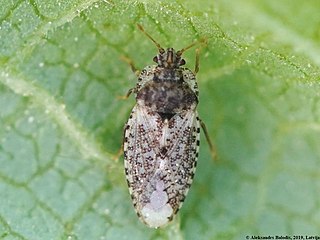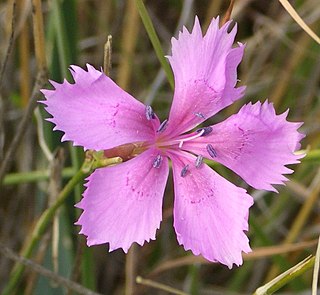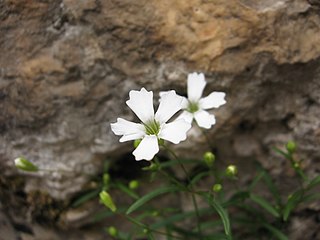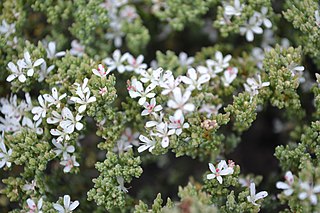
Caryophyllaceae, commonly called the pink family or carnation family, is a family of flowering plants. It is included in the dicotyledon order Caryophyllales in the APG III system, alongside 33 other families, including Amaranthaceae, Cactaceae, and Polygonaceae. It is a large family, with 81 genera and about 2,625 known species.

Paul Heinrich Gerhard Möhring was a German physician, botanist and zoologist.

Gypsophila is a genus of flowering plants in the carnation family, Caryophyllaceae. They are native to Eurasia, Africa, Australia, and the Pacific Islands. Turkey has a particularly high diversity of Gypsophila taxa, with about 35 endemic species. Some Gypsophila are introduced species in other regions.

Phrymaceae, also known as the lopseed family, is a small family of flowering plants in the order Lamiales. It has a nearly cosmopolitan distribution, but is concentrated in two centers of diversity, one in Australia, the other in western North America. Members of this family occur in diverse habitats, including deserts, river banks and mountains.

Morinda is a genus of flowering plants in the madder family, Rubiaceae. The generic name is derived from the Latin words morus "mulberry", from the appearance of the fruits, and indica, meaning "of India".

Arenaria is a genus of flowering plants, within the family Caryophyllaceae.

Minuartia is a genus of flowering plants commonly known as sandworts in the family Caryophyllaceae.

The Molluginaceae are a family of flowering plants recognized by several taxonomists. It was previously included in the larger family Aizoaceae. The APG III system of 2009 made no change in the status of the family as compared to the APG II system of 2003 and the APG system of 1998, apart from a reassignment of several genera, such as the placement of Corrigiola and Telephium into Caryophyllaceae, Corbichonia in Lophiocarpaceae, Microtea into Microteaceae and Limeum in Limeaceae, because the family was found to be widely polyphyletic in Caryophyllales. In addition Macarthuria was found not to be related to Limeum as previously thought and thus it was placed in Macarthuriaceae, and similarly species formerly placed in Hypertelis, apart from type species Hypertelis spergulacea, a true Molluginaceae, were found to belong elsewhere and were described as Kewa in the family Kewaceae, named for the Royal Botanic Gardens Kew. Molluginaceae is still assigned to the order Caryophyllales in the clade core eudicots, although the generic circumscription is difficult because Mollugo is not monophyletic.

Moehringia trinervia, commonly known as apetalous sandwort or three-nerved sandwort, is a herbaceous plant of the family Caryophyllaceae. A native of Eurasia, it has been introduced into North America.
Arenaria funiculata is a species of plant in the family Caryophyllaceae. It is endemic to Spain. Its natural habitat is rocky areas. It is threatened by habitat loss.

Piesmatidae is a small family of true bugs, commonly called ash-grey leaf bugs. The Piesmatidae are distributed mostly in the temperate Northern Hemisphere, with some occurring in Africa, Australia and South America. A common species found throughout the Americas is Piesma cinereum.

Caryophyllales is a diverse and heterogeneous order of flowering plants that includes the cacti, carnations, amaranths, ice plants, beets, and many carnivorous plants. Many members are succulent, having fleshy stems or leaves. The betalain pigments are unique in plants of this order and occur in all its families with the exception of Caryophyllaceae and Molluginaceae.

Moehringia macrophylla, commonly known as the largeleaf sandwort, is a species of flowering plant in the family Caryophyllaceae. It is native to parts of eastern and western North America, where it can be found in moist, shady habitat types, such as mountain forests. It is a rhizomatous perennial herb growing erect to about 18 centimeters in maximum height. The lance-shaped leaves are up to 5 centimeters long and oppositely arranged about the stem. The inflorescence is a cyme of 2 to 5 flowers, each with 5 pointed green sepals and 5 rounded white petals. The fruit is a toothed black capsule.

Cranichis is a genus of flowering plants from the orchid family, Orchidaceae. It contains about 50 species, native to South America, Central America, Mexico and the West Indies, with one species (C. muscosa) extending into Florida.

Heliosperma is a genus of flowering plants in the family Caryophyllaceae. As such, it is closely related to the large genus Silene, but its members can be told apart from Silene by the crest of long papillae on the seeds. The majority of the species are narrow endemics from the Balkan Peninsula, but H. alpestre is endemic to the Eastern Alps, and H. pusillum is found from the Cordillera Cantábrica in northern Spain to the Carpathians. Like members of the genus Silene and other related genera, Heliosperma is attacked by species of the anther smut fungus Microbotryum. Cases of parallel divergence events between alpine and mountain populations have been reported in this genus.

Frankenia is the only genus in the Frankeniaceae family of flowering plants. Other genera have been recognized within the family, such as Anthobryum, Hypericopsis and Niederleinia, but molecular phylogenetic studies have consistently shown that they all belong inside Frankenia. Frankenia comprises about 70–80 species of shrubs, subshrubs and herbaceous plants, adapted to saline and dry environments throughout temperate and subtropical regions. A few species are in cultivation as ornamental plants.
Caryocolum moehringiae is a moth of the family Gelechiidae. It is found from Germany to the Pyrenees, Italy and Greece.

Spergularia marina, also called Spergularia salina, is a species of flowering plant in the family Caryophyllaceae. It is known as salt sandspurry or lesser sea-spurrey. S. marina is a sprawling annual or sometimes perennial, with stems up to 35 cm (14 in) long. Like other sea-spurrey species, its flowers have white to pink petals, with sepals usually longer than the petals, at 2.5–4 mm (0.1–0.2 in). Plants are salt-tolerant, being found by the sea and in saline areas inland.
Pycnophyllopsis is a genus of flowering plants belonging to the family Caryophyllaceae.
















